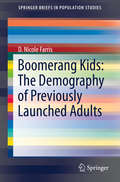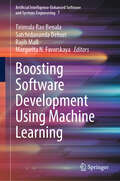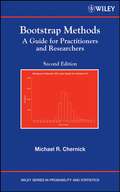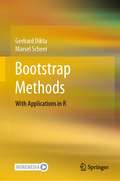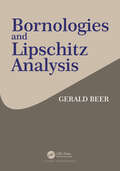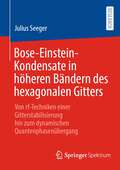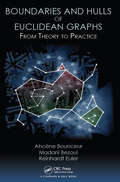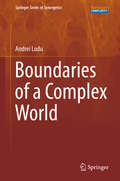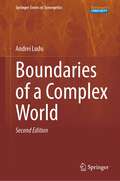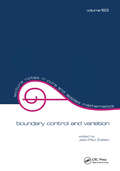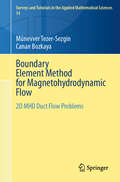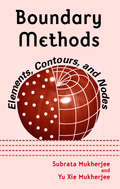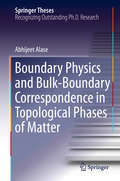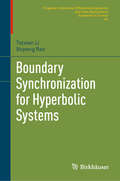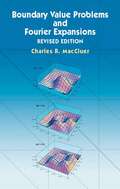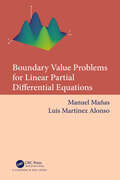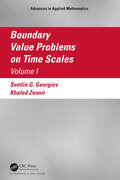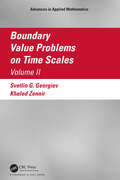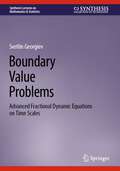- Table View
- List View
Boom-Bust Cycle, Asymmetrical Fiscal Response and the Dutch Disease
by Kareem Ismail Rabah ArezkiA report from the International Monetary Fund.
Boomerang Kids: The Demography of Previously Launched Adults (SpringerBriefs in Population Studies)
by D. Nicole FarrisCombining statistical analyses and personal interviews, this book examines the phenomenon of adult children in the United States who have returned to living with their parents in the family home. It uses both data and narrative to fully detail how such co-residency has shaped this ever-increasing demographic group, who are often referred to as "previously launched adults" or " boomerang children. " The author first presents quantitative research using data obtained from the National Survey of Families and Households. Readers will discover the various demographic, household, and economic variables that might lead an individual to move back in with his or her family. This statistical analysis is complemented by 50 qualitative interviews that offer a more in-depth look at the trend from the point of view of those who have experienced it. These interviews of both adult children and their parents cover such areas as personal background, the effects of returning to the parental home, and self-esteem issues. In addition, the book offers cross-country comparisons by looking at the prevalence of this phenomenon in China and Greece. It discusses the different cultural contexts in which adult child and parent co-residence is not seen as particularly deviant, as it is in America, as well as identifies some of the demographic and economic factors that would cause those in different countries to continue to live with their parents. This book furthers research into the sociological study of the family. The quantitative analyses describe the large scale trends and their implications, the interviews provide an important personal context, while the cross-country comparisons offer additional perspectives. Overall, readers will gain a complete picture of this unprecedented demographic shift in the United States, including important policy implications and the plight of young adults coming of age in the 21st century.
Boosting Software Development Using Machine Learning (Artificial Intelligence-Enhanced Software and Systems Engineering #7)
by Satchidananda Dehuri Margarita N. Favorskaya Rajib Mall Tirimula Rao BenalaThis book explores the transformative effects of AI and ML on software engineering. It emphasizes the potential of cutting-edge software development technologies such as Generative AI and ML applications. This book incorporates data-driven strategies across the entire software development life cycle, from requirements elicitation and design to coding, testing, and deployment. It illustrates the evolution from traditional frameworks to agile and DevOps methodologies. The potential of Generative AI for automating repetitive tasks and enhancing code quality is highlighted, along with ML applications in optimizing testing, effort estimation, design pattern recognition, fault prediction, debugging, and security through anomaly detection. These techniques have significantly improved software development efficiency, predictability, and project management effectiveness. While remarkable progress has been made, much remains to be done in this evolving area. This edited book is a timely effort toward advancing the field and promoting interdisciplinary collaboration in addressing ethical, security, and technical challenges.
Bootstrap Methods
by Michael R. ChernickA practical and accessible introduction to the bootstrap method----newly revised and updatedOver the past decade, the application of bootstrap methods to new areas of study has expanded, resulting in theoretical and applied advances across various fields. Bootstrap Methods, Second Edition is a highly approachable guide to the multidisciplinary, real-world uses of bootstrapping and is ideal for readers who have a professional interest in its methods, but are without an advanced background in mathematics.Updated to reflect current techniques and the most up-to-date work on the topic, the Second Edition features:The addition of a second, extended bibliography devoted solely to publications from 1999-2007, which is a valuable collection of references on the latest research in the fieldA discussion of the new areas of applicability for bootstrap methods, including use in the pharmaceutical industry for estimating individual and population bioequivalence in clinical trialsA revised chapter on when and why bootstrap fails and remedies for overcoming these drawbacksAdded coverage on regression, censored data applications, P-value adjustment, ratio estimators, and missing dataNew examples and illustrations as well as extensive historical notes at the end of each chapterWith a strong focus on application, detailed explanations of methodology, and complete coverage of modern developments in the field, Bootstrap Methods, Second Edition is an indispensable reference for applied statisticians, engineers, scientists, clinicians, and other practitioners who regularly use statistical methods in research. It is also suitable as a supplementary text for courses in statistics and resampling methods at the upper-undergraduate and graduate levels.
Bootstrap Methods and their Application
by A. C. Davison D. V. HinkleyBootstrap methods are computer-intensive methods of statistical analysis, which use simulation to calculate standard errors, confidence intervals, and significance tests. The methods apply for any level of modelling, and so can be used for fully parametric, semiparametric, and completely nonparametric analysis. This 1997 book gives a broad and up-to-date coverage of bootstrap methods, with numerous applied examples, developed in a coherent way with the necessary theoretical basis. Applications include stratified data; finite populations; censored and missing data; linear, nonlinear, and smooth regression models; classification; time series and spatial problems. Special features of the book include: extensive discussion of significance tests and confidence intervals; material on various diagnostic methods; and methods for efficient computation, including improved Monte Carlo simulation. Each chapter includes both practical and theoretical exercises. S-Plus programs for implementing the methods described in the text are available from the supporting website.
Bootstrap Methods: With Applications in R
by Gerhard Dikta Marsel ScheerThis book provides a compact introduction to the bootstrap method. In addition to classical results on point estimation and test theory, multivariate linear regression models and generalized linear models are covered in detail. Special attention is given to the use of bootstrap procedures to perform goodness-of-fit tests to validate model or distributional assumptions. In some cases, new methods are presented here for the first time. The text is motivated by practical examples and the implementations of the corresponding algorithms are always given directly in R in a comprehensible form. Overall, R is given great importance throughout. Each chapter includes a section of exercises and, for the more mathematically inclined readers, concludes with rigorous proofs. The intended audience is graduate students who already have a prior knowledge of probability theory and mathematical statistics.
Borders in Mathematics Pre-Service Teacher Education
by Limin Jao Nenad RadakovicThis book examines the current state of the field of mathematics pre-service teacher education through the theme of borders. Borders are ubiquitous; they can be used to define, classify, organize, make sense of, and/or group. There are many ways that the concept of a border illuminates the field of mathematics pre-service teacher education. Consequently, there are a multitude of responses to these borders: researchers and practitioners question, challenge, cross, blur, and erase them. Chapters include the following topics: explorations of mathematics across topics (e.g., geometry, algebra, probability) and with other disciplines (e.g., science, the arts, social sciences); challenging gender, cultural, and racial borders; exploring the structure and curriculum of teacher education programs; spaces inhabited by teacher education programs (e.g., university, community); and international collaborations and programs to promote cross-cultural sharing and learning. The book targets a readership of researchers and graduate students in integrated education studies, teacher education, practitioners of mathematics education, curriculum developers, and educational administrators and policy makers.
Born at the Right Time
by Doug OwramIt is rare in history for people to link their identity with their generation, and even rarer when children and adolescents actually shape society and influence politics. Both phenomena aptly describe the generation born in the decade following the Second World War. These were the baby boomers, viewed by some as the spoiled, selfish generation that had it all, and by others as a shock wave that made love and peace into tangible ideals. In this book, Doug Owram brings us the untold story of this famous generation as it played out its first twenty-five years in Canadian society.Beginning with Dr Spock's dictate that this particular crop of babies must be treated gently, Owram explores the myth and history surrounding this group, from its beginning at war's end to the close of the 1960s. The baby boomers wielded extraordinary power right from birth, Owram points out, and laid their claim on history while still in diapers. He sees the generation's power and sense of self stemming from three factors: its size, its affluent circumstance, and its connection with the 1960s - the fabulous decade of free love, flower power, women's liberation, drugs, protest marches, and rock 'n' roll. From Davy Crockett hats and Barbie dolls to the civil-rights movement and the sexual revolution, the concerns of this single generation became predominant themes for all of society. Thus, Owram's history of the baby-boomers is in many ways a history of the era.Doug Owram has written extensively on cultural icons, Utopian hopes, and the gap between realities and images - all powerful themes in the story of this idealistic generation. A well-researched, lucid, and humorous book, Born at the Right Time is the first Canadian history of the baby-boomers and the society they helped to shape.
Bornologies and Lipschitz Analysis
by Gerald BeerThis monograph, for the first time in book form, considers the large structure of metric spaces as captured by bornologies: families of subsets that contain the singletons, that are stable under finite unions, and that are stable under taking subsets of its members. The largest bornology is the power set of the space and the smallest is the bornology of its finite subsets. Between these lie (among others) the metrically bounded subsets, the relatively compact subsets, the totally bounded subsets, and the Bourbaki bounded subsets. Classes of functions are intimately connected to various bornologies; e.g., (1) a function is locally Lipschitz if and only if its restriction to each relatively compact subset is Lipschitz; (2) a subset is Bourbaki bounded if and only if each uniformly continuous function on the space is bounded when restricted to the subset. A great deal of attention is given to the variational notions of strong uniform continuity and strong uniform convergence with respect to the members of a bornology, leading to the bornology of UC-subsets and UC-spaces. Spaces on which its uniformly continuous real-valued functions are stable under pointwise product are characterized in terms of the coincidence of the Bourbaki bounded subsets with a usually larger bornology. Special attention is given to Lipschitz and locally Lipschitz functions. For example, uniformly dense subclasses of locally Lipschitz functions within the real-valued continuous functions, Cauchy continuous functions, and uniformly continuous functions are presented. It is shown very generally that a function between metric spaces has a particular metric property if and only if whenever it is followed in a composition by a real-valued Lipschitz function, the composition has the property. Bornological convergence of nets of closed subsets, having Attouch-Wets convergence as a prototype, is considered in detail. Topologies of uniform convergence for continuous linear operators between normed spaces is explained in terms of the bornological convergence of their graphs. Finally, the idea of a bornological extension of a topological space is presented, and all regular extensions can be so realized.
Bose-Einstein-Kondensate in höheren Bändern des hexagonalen Gitters: Von rf-Techniken einer Gitterstabilisierung hin zum dynamischen Quantenphasenübergang
by Julius SeegerDieses Buch beschreibt die erstmalige, erfolgreiche Realisierung unkonventioneller Superfluide in höheren Bändern des hexagonalen optischen Gitters. Der Populationstransfer und der anschließende dynamische Quantenphasenübergang werden ausführlich diskutiert. Schließlich werden die Metastabilität und Zerfallskanäle des ultrakalten Systems experimentell nachgewiesen. Durch die Reduktion von Phasenrauschen des optischen Gitters konnte die Lebensdauer des ultrakalten Ensembles um etwa eine Größenordnung erhöht werden. Weiterhin werden die optische Phasenregelschleife und Intensitätsstabilisierung des Gitters vorgestellt. Mit den in diesem Buch beschriebenen Ergebnissen und technologischen Entwicklungen werden die derzeit bestehenden Grenzen der Quantensimulation mittels ultrakalter Gase in optischen Gittern aufgehoben und der Weg für zahlreiche nachfolgende Untersuchungen bereitet.
Boundaries and Hulls of Euclidean Graphs: From Theory to Practice
by Ahcene Bounceur Madani Bezoui Reinhardt EulerBoundaries and Hulls of Euclidean Graphs: From Theory to Practice presents concepts and algorithms for finding convex, concave and polygon hulls of Euclidean graphs. It also includes some implementations, determining and comparing their complexities. Since the implementation is application-dependent, either centralized or distributed, some basic concepts of the centralized and distributed versions are reviewed. Theoreticians will find a presentation of different algorithms together with an evaluation of their complexity and their utilities, as well as their field of application. Practitioners will find some practical and real-world situations in which the presented algorithms can be used.
Boundaries of a Complex World (Springer Series in Synergetics)
by Andrei LuduThe centraltheme of this book is the extent to which the structure of the free dynamicalboundaries of a system controls the evolution of the system as a whole. Applyingthree orthogonal types of thinking - mathematical, constructivist andmorphological, it illustrates these concepts using applications to selectedproblems from the social and life sciences, as well as economics. In a broadercontext, it introduces and reviews some modern mathematical approaches to thescience of complex systems. Standard modeling approaches (based on non-lineardifferential equations, dynamic systems, graph theory, cellular automata,stochastic processes, or information theory) are suitable for studying localproblems. However they cannot simultaneously take into account all the differentfacets and phenomena of a complex system, and new approaches are required to solvethe challenging problem of correlations between phenomena at different levelsand hierarchies, their self-organization and memory-evolutive aspects, the growthof additional structures and are ultimately required to explain why and howsuch complex systems can display both robustness and flexibility. This graduate-leveltext also addresses a broader interdisciplinary audience, keeping themathematical level essentially uniform throughout the book, and involving onlybasic elements from calculus, algebra, geometry and systems theory.
Boundaries of a Complex World (Springer Series in Synergetics)
by Andrei LuduThe 2nd edition of this book provides novel topics and studyies in boundaries of networks and Big Data Systems.The central theme of this book is the extent to which the structure of the free dynamical boundaries of a system controls the evolution of the system as a whole. Applying three orthogonal types of thinking - mathematical, constructivist and morphological, it illustrates these concepts using applications to selected problems from the social and life sciences, as well as economics. In a broader context, it introduces and reviews some modern mathematical approaches to the science of complex systems. Standard modeling approaches (based on non-linear differential equations, dynamic systems, graph theory, cellular automata, stochastic processes, or information theory) are suitable for studying local problems. However they cannot simultaneously take into account all the different facets and phenomena of a complex system, and new approaches are required to solve the challenging problem of correlations between phenomena at different levels and hierarchies, their self-organization and memory-evolutive aspects, the growth of additional structures and are ultimately required to explain why and how such complex systems can display both robustness and flexibility. This graduate-level text addresses a broader interdisciplinary audience, keeping the mathematical level essentially uniform throughout the book, and involving only basic elements from calculus, algebra, geometry and systems theory.
Boundary Conformal Field Theory and the Worldsheet Approach to D-Branes
by Aptara. Inc Andreas RecknagelBoundary conformal field theory is concerned with a class of two-dimensional quantum field theories which display a rich mathematical structure and have many applications ranging from string theory to condensed matter physics. In particular, the framework allows discussion of strings and branes directly at the quantum level. Written by internationally renowned experts, this comprehensive introduction to boundary conformal field theory reaches from theoretical foundations to recent developments, with an emphasis on the algebraic treatment of string backgrounds. Topics covered include basic concepts in conformal field theory with and without boundaries, the mathematical description of strings and D-branes, and the geometry of strongly curved spacetime. The book offers insights into string geometry that go beyond classical notions. Describing the theory from basic concepts, and providing numerous worked examples from conformal field theory and string theory, this reference is of interest to graduate students and researchers in physics and mathematics.
Boundary Control and Variation (Lecture Notes in Pure and Applied Mathematics)
by Jean-Paul ZolesioBased on the Working Conference on Boundary Control and Boundary Variation held in Sophia-Antipolis, France, this work provides important examinations of shape optimization and boundary control of hyperbolic systems, including free boundary problems and stabilization. It offers a new approach to large and nonlinear variation of the boundary using g
Boundary Element Method for Magnetohydrodynamic Flow: 2D MHD Duct Flow Problems (Surveys and Tutorials in the Applied Mathematical Sciences #14)
by Münevver Tezer-Sezgin Canan BozkayaBoundary Element Method for Magnetohydrodynamic Flow” offers one of the first systematic and detailed treatments of the application of boundary element method (BEM) to magnetohydrodynamic (MHD) flow problems. It aims to fill in the gaps left by the earlier books on the application of BEM to some physical problems such as fluid dynamics, elasticity, and geophysics. An overview of the theory of MHD flow and a comprehensive mathematical formulation of BEM for convection-diffusion-type differential equations are provided by the authors, who heavily rely on their research and experience in the disciplines of BEM and MHD flow. The book first discusses the basic principles of the BEM approach for the MHD duct flow problems in coupled form with the fundamental solution derived by the authors. Specifically, the BEM solutions of MHD flow in pipes of rectangular or circular cross-sections, and MHD flow in infinite regions, are all covered emphasizing the convergence of infinite boundary integrals. This book, especially, concentrates on the MHD flow in regions with partly insulated partly perfectly conducting boundaries by BEM giving also the parabolic boundary layer thickness emanating from the points of discontinuities on the walls. The book secondly includes the dual reciprocity boundary element technique (DRBEM), an alternative form of BEM that expands the applicability of BEM to MHD flow and heat transfer problems as well as buoyancy MHD flow with magnetic potential and inductionless MHD flow. The purpose of the book is to serve as a research book for applied mathematicians, engineers, scientists, and graduate students who wish to learn in-depth about the formulation and application of BEM in MHD flow problems. As such, it is an invaluable resource and a major contribution to the numerical solution of MHD flow problems.
Boundary Integral Equation Methods and Numerical Solutions: Thin Plates on an Elastic Foundation (Developments in Mathematics #35)
by Christian Constanda Dale Doty William HamillThis book presents and explains a general, efficient, and elegant method for solving the Dirichlet, Neumann, and Robin boundary value problems for the extensional deformation of a thin plate on an elastic foundation. The solutions of these problems are obtained both analytically--by means of direct and indirect boundary integral equation methods (BIEMs)--and numerically, through the application of a boundary element technique. The text discusses the methodology for constructing a BIEM, deriving all the attending mathematical properties with full rigor. The model investigated in the book can serve as a template for the study of any linear elliptic two-dimensional problem with constant coefficients. The representation of the solution in terms of single-layer and double-layer potentials is pivotal in the development of a BIEM, which, in turn, forms the basis for the second part of the book, where approximate solutions are computed with a high degree of accuracy. The book is intended for graduate students and researchers in the fields of boundary integral equation methods, computational mechanics and, more generally, scientists working in the areas of applied mathematics and engineering. Given its detailed presentation of the material, the book can also be used as a text in a specialized graduate course on the applications of the boundary element method to the numerical computation of solutions in a wide variety of problems.
Boundary Methods: Elements, Contours, and Nodes (Mechanical Engineering)
by Subrata Mukherjee Yu Xie MukherjeeBoundary Methods: Elements, Contours, and Nodes presents the results of cutting-edge research in boundary-based mesh-free methods. These methods combine the dimensionality advantage of the boundary element method with the ease of discretization of mesh-free methods, both of which, for some problems, hold distinct advantages over the finite element
Boundary Physics and Bulk-Boundary Correspondence in Topological Phases of Matter (Springer Theses)
by Abhijeet AlaseThis thesis extends our understanding of systems of independent electrons by developing a generalization of Bloch’s Theorem which is applicable whenever translational symmetry is broken solely due to arbitrary boundary conditions. The thesis begins with a historical overview of topological condensed matter physics, placing the work in context, before introducing the generalized form of Bloch's Theorem. A cornerstone of electronic band structure and transport theory in crystalline matter, Bloch's Theorem is generalized via a reformulation of the diagonalization problem in terms of corner-modified block-Toeplitz matrices and, physically, by allowing the crystal momentum to take complex values. This formulation provides exact expressions for all the energy eigenvalues and eigenstates of the single-particle Hamiltonian. By precisely capturing the interplay between bulk and boundary properties, this affords an exact analysis of several prototypical models relevant to symmetry-protected topological phases of matter, including a characterization of zero-energy localized boundary excitations in both topological insulators and superconductors. Notably, in combination with suitable matrix factorization techniques, the generalized Bloch Hamiltonian is also shown to provide a natural starting point for a unified derivation of bulk-boundary correspondence for all symmetry classes in one dimension.
Boundary Synchronization for Hyperbolic Systems (Progress in Nonlinear Differential Equations and Their Applications #94)
by Tatsien Li Bopeng RaoWithin this carefully presented monograph, the authors extend the universal phenomenon of synchronization from finite-dimensional dynamical systems of ordinary differential equations (ODEs) to infinite-dimensional dynamical systems of partial differential equations (PDEs). By combining synchronization with controllability, they introduce the study of synchronization to the field of control and add new perspectives to the investigation of synchronization for systems of PDEs. With a focus on synchronization for a coupled system of wave equations, the text is divided into three parts corresponding to Dirichlet, Neumann, and coupled Robin boundary controls. Each part is then subdivided into chapters detailing exact boundary synchronization and approximate boundary synchronization, respectively. The core intention is to give artificial intervention to the evolution of state variables through appropriate boundary controls for realizing the synchronization in a finite time, creating a novel viewpoint into the investigation of synchronization for systems of partial differential equations, and revealing some essentially dissimilar characteristics from systems of ordinary differential equations. Primarily aimed at researchers and graduate students of applied mathematics and applied sciences, this text will particularly appeal to those interested in applied PDEs and control theory for distributed parameter systems.
Boundary Value Problems and Fourier Expansions
by Charles R. MaccluerBased on modern Sobolev methods, this text for advanced undergraduates and graduate students is highly physical in its orientation. It integrates numerical methods and symbolic manipulation into an elegant viewpoint that is consonant with implementation by digital computer. The first five sections form an informal introduction that develops students' physical and mathematical intuition. The following section introduces Hilbert space in its natural environment, and the next six sections pose and solve the standard problems. The final seven sections feature concise introductions to selected topics, including Sturm-Liouville problems, Fourier integrals, Galerkin's method, and Sobolev methods. 1994 edition. 64 figures. Exercises.
Boundary Value Problems for Linear Partial Differential Equations
by Manuel Mañas Luis Martínez AlonsoBoundary value problems play a significant role in modeling systems characterized by established conditions at their boundaries. On the other hand, initial value problems hold paramount importance in comprehending dynamic processes and foreseeing future behaviors. The fusion of these two types of problems yields profound insights into the intricacies of the conduct exhibited by many physical and mathematical systems regulated by linear partial differential equations.Boundary Value Problems for Linear Partial Differential Equations provides students with the opportunity to understand and exercise the benefits of this fusion, equipping them with realistic, practical tools to study solvable linear models of electromagnetism, fluid dynamics, geophysics, optics, thermodynamics and specifically, quantum mechanics. Emphasis is devoted to motivating the use of these methods by means of concrete examples taken from physical models. Features No prerequisites apart from knowledge of differential and integral calculus and ordinary differential equations. Provides students with practical tools and applications Contains numerous examples and exercises to help readers understand the concepts discussed in the book.
Boundary Value Problems on Time Scales, Volume I (Advances in Applied Mathematics)
by Svetlin G. Georgiev Khaled ZennirBoundary Value Problems on Time Scales, Volume I is devoted to the qualitative theory of boundary value problems on time scales. Summarizing the most recent contributions in this area, it addresses a wide audience of specialists such as mathematicians, physicists, engineers and biologists. It can be used as a textbook at the graduate level and as a reference book for several disciplines. The text contains two volumes, both published by Chapman & Hall/CRC Press. Volume I presents boundary value problems for first- and second-order dynamic equations on time scales. Volume II investigates boundary value problems for three, four, and higher-order dynamic equations on time scales. Many results to differential equations carry over easily to corresponding results for difference equations, while other results seem to be totally different in nature. Because of these reasons, the theory of dynamic equations is an active area of research. The time-scale calculus can be applied to any field in which dynamic processes are described by discrete or continuous time models. The calculus of time scales has various applications involving noncontinuous domains such as certain bug populations, phytoremediation of metals, wound healing, maximization problems in economics, and traffic problems. Boundary value problems on time scales have been extensively investigated in simulating processes and the phenomena subject to short-time perturbations during their evolution. The material in this book is presented in highly readable, mathematically solid format. Many practical problems are illustrated displaying a wide variety of solution techniques. AUTHORS Svetlin G. Georgiev is a mathematician who has worked in various areas of the study. He currently focuses on harmonic analysis, functional analysis, partial differential equations, ordinary differential equations, Clifford and quaternion analysis, integral equations, and dynamic calculus on time scales. Khaled Zennir earned his PhD in mathematics in 2013 from Sidi Bel Abbès University, Algeria. In 2015, he received his highest diploma in Habilitation in mathematics from Constantine University, Algeria. He is currently assistant professor at Qassim University in the Kingdom of Saudi Arabia. His research interests lie in the subjects of nonlinear hyperbolic partial differential equations: global existence, blowup, and long-time behavior.
Boundary Value Problems on Time Scales, Volume II (Advances in Applied Mathematics)
by Svetlin G. Georgiev Khaled ZennirBoundary Value Problems on Time Scales, Volume II is devoted to the qualitative theory of boundary value problems on time scales. Summarizing the most recent contributions in this area, it addresses a wide audience of specialists such as mathematicians, physicists, engineers and biologists. It can be used as a textbook at the graduate level and as a reference book for several disciplines. The text contains two volumes, both published by Chapman & Hall/CRC Press. Volume I presents boundary value problems for first- and second-order dynamic equations on time scales. Volume II investigates boundary value problems for three, four, and higher-order dynamic equations on time scales. Many results to differential equations carry over easily to corresponding results for difference equations, while other results seem to be totally different in nature. Because of these reasons, the theory of dynamic equations is an active area of research. The time-scale calculus can be applied to any field in which dynamic processes are described by discrete or continuous time models. The calculus of time scales has various applications involving noncontinuous domains such as certain bug populations, phytoremediation of metals, wound healing, maximization problems in economics, and traffic problems. Boundary value problems on time scales have been extensively investigated in simulating processes and the phenomena subject to short-time perturbations during their evolution. The material in this book is presented in highly readable, mathematically solid format. Many practical problems are illustrated displaying a wide variety of solution techniques. AUTHORS Svetlin G. Georgiev is a mathematician who has worked in various areas of the study. He currently focuses on harmonic analysis, functional analysis, partial differential equations, ordinary differential equations, Clifford and quaternion analysis, integral equations, and dynamic calculus on time scales. Khaled Zennir earned his PhD in mathematics in 2013 from Sidi Bel Abbès University, Algeria. In 2015, he received his highest diploma in Habilitation in mathematics from Constantine University, Algeria. He is currently assistant professor at Qassim University in the Kingdom of Saudi Arabia. His research interests lie in the subjects of nonlinear hyperbolic partial differential equations: global existence, blowup, and long-time behavior.
Boundary Value Problems: Advanced Fractional Dynamic Equations on Time Scales (Synthesis Lectures on Mathematics & Statistics)
by Svetlin GeorgievThis book explores boundary value problems for fractional dynamic equations on arbitrary time scales, including Caputo fractional dynamic equations, impulsive Caputo fractional dynamic equations, and impulsive Riemann-Liouville fractional dynamic equations. The author provides an introduction to each fractional dynamic equation before delving into the problems. The book also covers initial value problems, boundary value problems, initial boundary value problems for each type of equation. The author provides integral representations of the solutions and proves the existence and uniqueness of the solutions.

